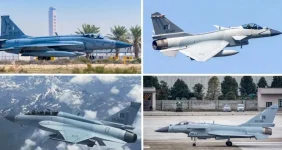- Views: 3K
- Replies: 11
In a significant development, the Indian Air Force (IAF) has reportedly destroyed a sophisticated Chinese-made YLC-8E anti-stealth radar system stationed at Pakistan's Chunian Air Base.
The radar, described as a flagship of Chinese stealth detection technology, was eliminated during "Operation Sindoor," an Indian retaliatory offensive launched on May 7, 2025, which targeted military assets and alleged terrorist infrastructure within Pakistan.
The YLC-8E radar, operating in the UHF-band, is a three-dimensional surveillance system developed by the state-owned China Electronics Technology Group Corporation (CETC). This advanced system was reportedly transferred from the People’s Liberation Army’s own inventory to Pakistan in 2023. Its deployment was seen as a move to counter India's advanced ELM-2090U Ultra UHF radars.
Chinese state media had previously lauded the YLC-8E as the world's pioneering UHF-band anti-stealth radar. The system boasts a very large antenna, comparable in size to two badminton courts, and employs powerful signal processing to detect modern stealth aircraft like the F-22 and F-35 from over 500 kilometres away.
It was also designed to track missile threats up to 700 kilometres, providing high-definition targeting information. China marketed this radar as superior to international competitors due to its active phase-controlled array and innovative anti-stealth features, positioning it as a key component of modern air defence networks.
Chunian Air Base, situated approximately 70 kilometres south of Lahore in Pakistan's Punjab province, is a vital installation for the Pakistan Air Force (PAF) and Pakistan Army aviation units, including fixed-wing aircraft.
The placement of the YLC-8E radar at this forward location was intended to strengthen Pakistan's Comprehensive Layered Integrated Air Defence (CLIAD) system. This was particularly aimed at countering India's Rafale fighter jets and long-range munitions such as the BrahMos and SCALP cruise missiles.
However, reports confirmed by satellite imagery and Indian military briefings on May 10, 2025, indicated the destruction of the YLC-8E radar and other air defence equipment at Chunian, as well as at Pasrur and Arifwala. This has reportedly created a substantial vulnerability in Pakistan's early warning and airspace monitoring capabilities in the central Punjab region.
During a press conference, Air Marshal A.K. Bharti of the Indian Air Force stated that advanced air-launched cruise missiles (ALCMs), believed to be BrahMos missiles, were used to carry out precise attacks on Pakistani military installations, including the YLC-8E radar.
This strike is said to have significantly disrupted Pakistan's radar coverage and communications infrastructure crucial for its air defence, thereby allowing Indian aircraft to operate more freely within Pakistani airspace.
The successful neutralisation of the YLC-8E, despite its advertised advanced anti-stealth and anti-jamming features, has raised questions regarding its actual operational effectiveness, particularly under Pakistani operation.
Reports indicate that some Chinese citizens have expressed disappointment on social media, suggesting that the failure might be due to inadequate training and integration by Pakistan, rather than inherent flaws in the radar system itself, reflecting previous concerns over Pakistan's handling of other Chinese-supplied systems like the HQ-9 and PL-15E.
The destruction of the YLC-8E radar represents a strategic blow to both Pakistan's defence capabilities and China's reputation as a supplier of advanced military technology.
For Pakistan, this loss weakens its ability to detect and respond to Indian aerial threats in its eastern territories. For China, the incident casts doubt on the real-world performance of its defence exports, as the YLC-8E was promoted as a capable counter to sophisticated Western and Indian radar technologies.
Indian defence analysts propose that the IAF’s own ELM-2090U radars, augmented by electronic warfare systems and real-time intelligence, likely overcame the YLC-8E, exposing potential limitations in its anti-jamming and target-tracking functions.
This strike is also consistent with India's broader strategy of Suppression of Enemy Air Defences (SEAD), a critical component of modern air warfare aimed at dismantling an adversary's air defence network.
This operation reportedly targeted Pakistani radar installations, command and control centres, and weapon storage sites across eight different bases, including Rafiqui, Murid, and Sukkur.

